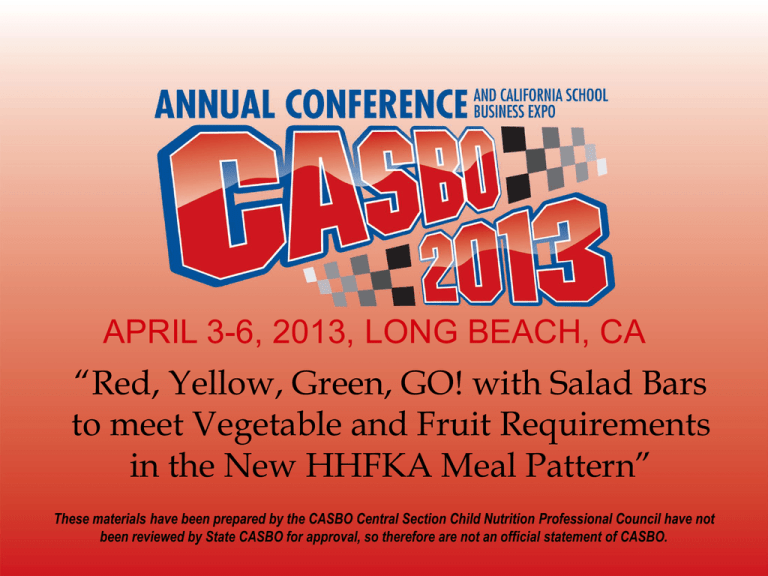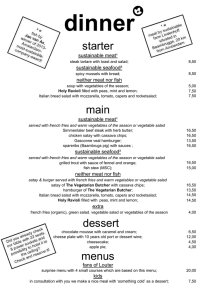Salad Bars - California Association of School Business Officials
advertisement

APRIL 3-6, 2013, LONG BEACH, CA “Red, Yellow, Green, GO! with Salad Bars to meet Vegetable and Fruit Requirements in the New HHFKA Meal Pattern” These materials have been prepared by the CASBO Central Section Child Nutrition Professional Council have not been reviewed by State CASBO for approval, so therefore are not an official statement of CASBO. “Red, Yellow, Green, GO! with Salad Bars to meet Vegetable and Fruit Requirements in the New HHFKA Meal Pattern” Regina G. Ocampo Sanger Unified School District Child Nutrition Director Review requirements for successful implementation of salad bars in schools Best Practices: Present ways salad bars can be instrumental in helping schools meet new meal regulations Review Requirements Discuss different styles of salad bars Review menu production record requirements Review point of service requirements Review food safety aspects Positive way to promote your school meal program and fresh products Great way to offer a wide variety of fruits and vegetables and increase daily consumption Assist schools in meeting the vegetable subgroup requirements Attractive way to encourage students to try new foods Can service multiple lines HHFKA 2012-2013 National School Lunch Meal Pattern Grades K-5 Grades 6-8 Grades 9-12 Amount of Food Per Week (Minimum Per Day) Meal Components Fruits (cups) 2½ (½) 2½ (½) 5 (1) Vegetables (cups) 3¾ (¾) 3¾ (¾) 5 (1) Dark green ½ ½ ½ Red/Orange ¾ ¾ 1¼ Beans and peas (legumes) ½ ½ ½ Starchy ½ ½ ½ Other ½ ½ ¾ 1 1 1½ Grains (oz. eq) 8-9 (1) 8-10 (1) 10-12 (2) Meats/Meat Alternates (oz. eq) 8-10 (1) 9-10 (1) 10-12 (2) 5 (1) 5 (1) 5 (1) Additional Veg to Reach Total Fluid milk (cups) HHFKA 2012-2013 National School Lunch Meal Pattern Grades K-5 Grades 9-12 Amount of Food Per Week (Minimum Per Day) Meal Components Fruits (cups) Grades 6-8 2½ (½) 2½ (½) 5 (1) HHFKA 2012-2013 National School Lunch Meal Pattern Grades K-5 Grades 6-8 Grades 9-12 Amount of Food Per Week (Minimum Per Day) Meal Components 3¾ (¾) 3¾ (¾) 5 (1) Dark green ½ ½ ½ Red/Orange ¾ ¾ 1¼ Beans and peas (legumes) ½ ½ ½ Starchy ½ ½ ½ Other ½ ½ ¾ Additional Veg to Reach Total 1 1 1½ Vegetables (cups) Be sure to offer enough per day to equal the minimum over the week! Consistent with the meal pattern For age/grade grouping For Offer vs. Serve Pre-portioning: ¼ cup and ½ cup servings for K-8 ½ cup servings may be better for 9-12 Appropriate 1 cup salad greens vs. 1 cup radishes Affordable 1 cup fresh pineapple vs. 1 cup fresh apple Purchase “In-Season” and “Regional” fresh produce Plan choices for ease of selection ½ cup fruit ¼ cup and ½ cup vegetables A vegetable mix with at least 1/8 cup of each type of veggie A combo of fruits and vegetables to meet ½ cup If offered on the salad bar, do they meet the daily minimum meal requirements? 1 oz. M/MA and 1 Grain for K-8 2 oz. M/MA and 2 Grains for 9-12 Do they meet the weekly minimum (and not exceed maximum [now flexible!]) for M/MA and Grains requirements? Consider offering a pre- portioned M/MA “Salad Topper” on the serving line OR a separate “Topper Bar” with M/MA and Grain choices If a student has selected a serving of milk and no M/MA or Grain choices, what does the student need to select from the salad bar in order to have a reimbursable meal?? Located at or near the beginning of serving line Simple and easy to understand Possible color coding of food choices to match color coding on signs Colorful photos of food choices may help 19 USDA memo SP 02-2010 (Revised): Salad Bars in the National School Lunch Program (provided) Website Resources: Wake Up to Fresh Fruits and Vegetables http://www.wakeupfv.com Fruit and Vegetables Galore http://www.fns.usda.gov/tn/resources/fv_galore.html Harvest of the Month Fresh Fruit and Vegetable Grants Alliance for a Healthier Generation US Healthier School Challenge Fruit and Vegetable choices only Choices for an entire reimbursable meal Theme Bars Baked Potato Bar Taco Bar Pasta Bar Burger Bar Sandwich Bar Traditional self-serve Pre-portioned, pre-packed choices Grab and Go sides at multiple windows Farmer’s Market Harvest Bar Choose the one that best meets the needs of your program Custom Design = Endless Possibilities! 26 Incorporate fresh, local (or regional) produce Promote Farm to School programs Connect with School Gardens (if available) Michelle Obama’s campaign Goal to bring 6,000 new salad bars into Child Nutrition programs http://www.saladbars2schools.org Research based techniques developed at Cornell University http://www.smarterlunchrooms.org Offer fruit in at least two locations Offer fruit in bowl or basket Name vegetables creatively Visual prompting – Signage “Fresh Salad Bar with every entrée” “Last chance to choose fruit” “Fresh fruits and vegetables choices with every lunch” Attractive and Inviting Variety Color Texture Shape Presentation Install TV monitors in Cafeterias Highlight Photos of daily menu options Show sample tray choices Provide Nutrition Education Play Trivia Quizzes – Make it FUN Place photos of serving sizes placed above food item serve as a helpful guide Utilize My Plate/My Tray Tie your menu and nutrition education back to your district’s Student Wellness Policy Promote at Back to School Night Programs Display salad bar filled with actual daily choices Educate parents, families and community about choices and portion requirements Provide Salad to each school site lead Bar selections consistent Planned for maximum customer appeal With the new Food Based Menu Planning Every item offered on the salad bar must be listed and accounted for separately on the Menu Production Record (MPR) No longer list the salad bar recipe number on MPR Pre-print the salad bar MPR with most of required information Can be used to conduct your own nutrient analysis Helpful way to establish and provide direction to site staff on daily set up of salad bar choices Critical to use historical data from MPR to develop salad bar recipes and continually update information based on student consumption (usage study) Definition: The point at which you can determine if the student took the required meal components for a reimbursable meal NOTE: Even if the student selected ½ cup of fruit and/or vegetable with the entrée, the student must still go by the salad bar line and be offered all of the fruit and vegetable subgroups of the meal If the cashier is located before the salad bar, a monitor must check the meal at the end of the line to ensure that it is reimbursable. The monitor can make the student take the ½ cup fruit and/or vegetable requirement. Place a bowl of fruit and boxes of raisins/dried fruit at the end of the line. The monitor also helps ensure food safety. If space is a concern, consider placing the salad bar before the hot serving line. Placing fruit and vegetable choices at the beginning of the line encourages the selection and consumption of more fruits and vegetables. Food Safety is our #1 priority. Ensure our food is safe for our customers Reduce the risk of food-borne illness Healthy customers = Happy customers! Supply clean utensils and dispensers Monitor salad bar during meal service Train staff on proper monitoring for food components as well as food safety Post signs on salad bar etiquette Install hand sanitizing stations in cafeteria Dispose of leftovers properly, using your SOP If using time as a food safety measure rather than temperature for your site, be sure to have a SOP in place and use a time log to document Wash hands before entering cafeteria or use hand sanitizing station in cafeteria Stay behind the sneeze guard Do NOT touch the food with hands Do not come back for seconds with the same tray (new tray each time) Take what you would like and only what you can eat Do NOT return food to the salad bar Use tongs and utensils correctly! Work with primary teachers to send sets of pans, tongs and utensils to classrooms so students can practice Record video of proper use of the salad bar and use as a classroom teaching tool Local Interpretations of Food Codes and Regulations may vary among local health departments Best to work with your local health department to find the solutions to your individual situations Develop a positive working relationship; become partners in providing the best for your customers Federal Food and Nutrition Services (FNS), USDA http://www.fns.usda.gov/fns/safety/produce-safety.htm FDA Food Code http://www.fda.gov/Food/FoodSafety/RetailFoodProtection/Food Code/FoodCode2009/ucm186451.htm State California Retail Food Code http://www.cdph.ca.gov/services/documents/fdbRFC.pdf Best Practices: Handling Fresh Produce in Schools http://nfsmi.org/documentlibraryfiles/PDF/20110 822025744.pdf HACCP Based SOPs Preventing Contamination at Food Bars http://sop.nfsmi.org/HACCPBasedSOPs/Preventi ngContaminationatFoodBars.pdf Provide locally grown, delicious, fresh produce to students and staff In-season, regional, specifically California Partner with community and showcase your Child Nutrition Program Strong support from USDA and CDE Partner with farmers, farmer’s markets, local chefs, farming cooperatives and other groups to help promote and serve California produce Helpful website: http://www.healthyschoolenvironment.org/farmtoschool SNA Meal Pattern Companion Guide Network for a Healthy California http://www.cdph.ca.gov/programs/cpns/Pages/Powe rPlayResources.aspx Harvest of the Month http://www.schoolnutrition.org/mealpattern http://www.harvestofthemonth.cdph.ca.gov/ Recipes for Kids Challenge http://www.recipesforkidschallenge.com/ Any Questions?




